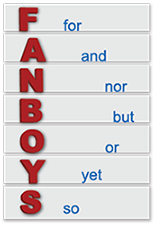Introduction: Connecting Your Learning
 Understanding the eight basic parts of speech (noun, pronoun, adjective, verb, adverb, conjunction, interjection, and preposition) will help you determine how words function in a sentence and ultimately, enable you to construct correct sentences. Constructing better sentences will make you a better communicator.
Understanding the eight basic parts of speech (noun, pronoun, adjective, verb, adverb, conjunction, interjection, and preposition) will help you determine how words function in a sentence and ultimately, enable you to construct correct sentences. Constructing better sentences will make you a better communicator.
| Readings, Resources, and Assignments | |
|---|---|
| Required Readings | Read the following before starting the lesson: |
| Multimedia Resources | Parts of Speech PowerPoint presentation (Click on the PowerPoint icon to view the presentation) |
| Required Assignments |
|
Focusing Your Learning
Lesson Objectives
By the end of this lesson, you should be able to:
- Identify the eight parts of speech and their functions.
Key Terms
Presentation
 Thousands of words are found in the English language; however, not all words have the same function. Think of these words like the components of a computer. Each of the components has its own job. The central processing unit (CPU) processes the information, the random-access memory (RAM) holds information for processing, the video card converts the information into graphics, and the keyboard and mouse input information from a user. In English you use various words with different functions to make sentences much like each computer component has a certain role in the information process.
Thousands of words are found in the English language; however, not all words have the same function. Think of these words like the components of a computer. Each of the components has its own job. The central processing unit (CPU) processes the information, the random-access memory (RAM) holds information for processing, the video card converts the information into graphics, and the keyboard and mouse input information from a user. In English you use various words with different functions to make sentences much like each computer component has a certain role in the information process.
Words are categorized into eight types called parts of speech: noun, pronoun, adjective, verb, adverb, conjunction, interjection, and preposition. For simplicity, they are categorized into families.
Noun Family noun pronoun adjective |
Verb Family verb adverb |
Tion Family conjunction interjection preposition |
Noun Family
- A noun names a person, place, or thing.
A noun can be common such as woman, city, or country, or it can be proper like Suzi, Phoenix, or Canada. Notice that common nouns are not capitalized while proper nouns are capitalized. Nouns can also be concrete like desk, house, or ocean, or abstract like freedom, love, or democracy. Notice that concrete nouns can be experienced by the five senses while abstract nouns cannot.
- A pronoun replaces a noun.
I, me, you, he, him, she, her, it, we, us, they, them, anything, anyone, everyone, theirs
- An adjective modifies (changes) a noun.
Adjectives answer questions about the noun like what kind, which, or how many.
Verb Family
- A verb expresses an action, makes a statement, or shows a link.
- An adverb modifies (changes) a verb, an adjective, or another adverb. Adverbs answer where, when, how, how often, and to what extent. Many adverbs end in "ly" although not all do. All adverbs in the sentences below are bolded.
- She drove slowly. (Here the adverb is modifying the verb, drove.)
- She drove incredibly slowly. (Here the adverb is modifying the adverb, slowly)
- The car was amazingly fast. (Here the adverb is modifying the adjective, fast).
Tion Family (Family members all share the same last name--Tion.)
- A conjunction joins words or groups of words together. There are two main types of conjunctions: subordinating and coordinating.
 Coordinating conjunctions like the acronym FANBOYS (for, and, nor, but, or, yet, and so) join words, phrases, and clauses of equal value.
Coordinating conjunctions like the acronym FANBOYS (for, and, nor, but, or, yet, and so) join words, phrases, and clauses of equal value.
- I like peas and carrots.
- I will eat my breakfast and make my bed.
- I am tired, but I have miles still to go.
Subordinating conjunctions join words, phrases and clauses of unequal value.
The most common subordinating conjunctions include the following: since, after, when, before, if, although, because, as, while, until, and whether.
- An interjection interjects, expressing a strong emotion but having no grammatical function.
- Think of an interjection like a "Batman" word: for example, Oh!, Ouch!, Great!, Aha!, No!
- A preposition shows relationships between nouns and pronouns and other words in a sentence
- A preposition must be used in a phrase to be a preposition (to the store, on the desk, beside the car).
Common prepositions include the following: aboard, about, above, across, after, against, along, among, around, at, before, behind, below, beneath, beside, between, beyond, by, down, during, except, for, from, in, into, like, of, off, on, over, past, since, through, throughout, to, toward, under, underneath, until, up, upon, with, within, and without.
Gaining an understanding of the eight basic parts of speech is important. Take some time and go through the Parts of Speech presentation for further explanation and examples.
Parts of Speech PowerPoint Presentation (Click on the PowerPoint icon to view the presentation)
On Your Own
Conduct a search to see if you can find the classic video series Grammar Rock on the Internet!
Practice
Try these interactive practice exercises:
 |
For additional practice, you will need a piece of paper and a pen or pencil to complete the activity below.
Writing at Work Practice Activity: Write a memo announcing the annual company potluck. The memo will be posted in all departments, and it should welcome everyone and ask that each person contribute a dish for the buffet table. Be sure to use all eight parts of speech, and underline and label each part.
Summarizing Your Learning
In the English language, there are the eight parts of speech. Just like there are different components of a computer, different words are used to create sentences. Not every component or part of speech will be used in every sentence. However, a sentence must include both a noun or pronoun and a verb.
For more on parts of speech, see this PowerPoint presentation about building sentences.
Diagramming Sentences PowerPoint Presentation
Assessing Your Learning
 |
Now it is time to show what you have learned. Complete the assignments below. |
- Grammar: Defining Parts of Speech
- Grammar: Identifying Parts of Speech